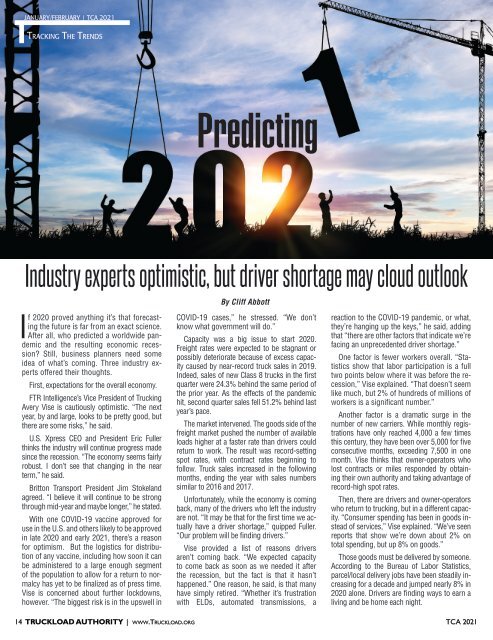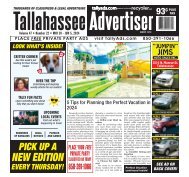TLA46_AllPages
Create successful ePaper yourself
Turn your PDF publications into a flip-book with our unique Google optimized e-Paper software.
JANUARY/FEBRUARY | TCA 2021<br />
Tracking The Trends<br />
Predicting<br />
Industry experts optimistic, but driver shortage may cloud outlook<br />
By Cliff Abbott<br />
If 2020 proved anything it’s that forecasting<br />
the future is far from an exact science.<br />
After all, who predicted a worldwide pandemic<br />
and the resulting economic recession?<br />
Still, business planners need some<br />
idea of what’s coming. Three industry experts<br />
offered their thoughts.<br />
First, expectations for the overall economy.<br />
FTR Intelligence’s Vice President of Trucking<br />
Avery Vise is cautiously optimistic. “The next<br />
year, by and large, looks to be pretty good, but<br />
there are some risks,” he said.<br />
U.S. Xpress CEO and President Eric Fuller<br />
thinks the industry will continue progress made<br />
since the recession. “The economy seems fairly<br />
robust. I don’t see that changing in the near<br />
term,” he said.<br />
Britton Transport President Jim Stokeland<br />
agreed. “I believe it will continue to be strong<br />
through mid-year and maybe longer,” he stated.<br />
With one COVID-19 vaccine approved for<br />
use in the U.S. and others likely to be approved<br />
in late 2020 and early 2021, there’s a reason<br />
for optimism. But the logistics for distribution<br />
of any vaccine, including how soon it can<br />
be administered to a large enough segment<br />
of the population to allow for a return to normalcy<br />
has yet to be finalized as of press time.<br />
Vise is concerned about further lockdowns,<br />
however. “The biggest risk is in the upswell in<br />
COVID-19 cases,” he stressed. “We don’t<br />
know what government will do.”<br />
Capacity was a big issue to start 2020.<br />
Freight rates were expected to be stagnant or<br />
possibly deteriorate because of excess capacity<br />
caused by near-record truck sales in 2019.<br />
Indeed, sales of new Class 8 trucks in the first<br />
quarter were 24.3% behind the same period of<br />
the prior year. As the effects of the pandemic<br />
hit, second quarter sales fell 51.2% behind last<br />
year’s pace.<br />
The market intervened. The goods side of the<br />
freight market pushed the number of available<br />
loads higher at a faster rate than drivers could<br />
return to work. The result was record-setting<br />
spot rates, with contract rates beginning to<br />
follow. Truck sales increased in the following<br />
months, ending the year with sales numbers<br />
similar to 2016 and 2017.<br />
Unfortunately, while the economy is coming<br />
back, many of the drivers who left the industry<br />
are not. “It may be that for the first time we actually<br />
have a driver shortage,” quipped Fuller.<br />
“Our problem will be finding drivers.”<br />
Vise provided a list of reasons drivers<br />
aren’t coming back. “We expected capacity<br />
to come back as soon as we needed it after<br />
the recession, but the fact is that it hasn’t<br />
happened.” One reason, he said, is that many<br />
have simply retired. “Whether it’s frustration<br />
with ELDs, automated transmissions, a<br />
reaction to the COVID-19 pandemic, or what,<br />
they’re hanging up the keys,” he said, adding<br />
that “there are other factors that indicate we’re<br />
facing an unprecedented driver shortage.”<br />
One factor is fewer workers overall. “Statistics<br />
show that labor participation is a full<br />
two points below where it was before the recession,”<br />
Vise explained. “That doesn’t seem<br />
like much, but 2% of hundreds of millions of<br />
workers is a significant number.”<br />
Another factor is a dramatic surge in the<br />
number of new carriers. While monthly registrations<br />
have only reached 4,000 a few times<br />
this century, they have been over 5,000 for five<br />
consecutive months, exceeding 7,500 in one<br />
month. Vise thinks that owner-operators who<br />
lost contracts or miles responded by obtaining<br />
their own authority and taking advantage of<br />
record-high spot rates.<br />
Then, there are drivers and owner-operators<br />
who return to trucking, but in a different capacity.<br />
“Consumer spending has been in goods instead<br />
of services,” Vise explained. “We’ve seen<br />
reports that show we’re down about 2% on<br />
total spending, but up 8% on goods.”<br />
Those goods must be delivered by someone.<br />
According to the Bureau of Labor Statistics,<br />
parcel/local delivery jobs have been steadily increasing<br />
for a decade and jumped nearly 8% in<br />
2020 alone. Drivers are finding ways to earn a<br />
living and be home each night.<br />
14 TRUCKLOAD AUTHORITY | www.Truckload.org TCA 2021

















